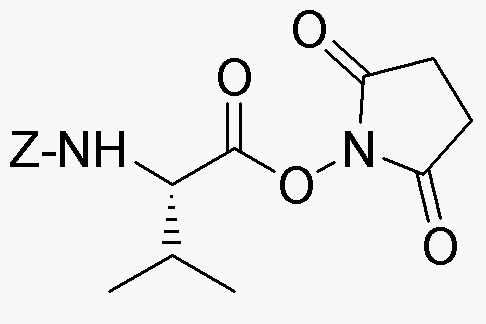Z-L-valine N-hydroxysuccinimide ester is widely utilized in research focused on:
- Peptide Synthesis: This compound serves as a valuable reagent in the synthesis of peptides, allowing for the formation of stable amide bonds. Its use can enhance the efficiency of producing complex peptides in pharmaceutical research.
- Drug Development: In the pharmaceutical industry, it is employed to modify drug molecules, improving their solubility and bioavailability. This modification can lead to more effective therapeutic agents.
- Bioconjugation: It facilitates the conjugation of biomolecules, such as proteins and antibodies, to various carriers. This application is crucial in developing targeted drug delivery systems, enhancing the specificity of treatments.
- Diagnostics: The compound is used in the preparation of diagnostic agents, aiding in the detection of diseases. Its ability to form stable conjugates makes it ideal for creating reliable diagnostic tools.
- Research in Proteomics: In proteomics, it assists in labeling proteins for mass spectrometry analysis, enabling researchers to study protein interactions and functions more effectively.
General Information
Properties
Safety and Regulations
Applications
Z-L-valine N-hydroxysuccinimide ester is widely utilized in research focused on:
- Peptide Synthesis: This compound serves as a valuable reagent in the synthesis of peptides, allowing for the formation of stable amide bonds. Its use can enhance the efficiency of producing complex peptides in pharmaceutical research.
- Drug Development: In the pharmaceutical industry, it is employed to modify drug molecules, improving their solubility and bioavailability. This modification can lead to more effective therapeutic agents.
- Bioconjugation: It facilitates the conjugation of biomolecules, such as proteins and antibodies, to various carriers. This application is crucial in developing targeted drug delivery systems, enhancing the specificity of treatments.
- Diagnostics: The compound is used in the preparation of diagnostic agents, aiding in the detection of diseases. Its ability to form stable conjugates makes it ideal for creating reliable diagnostic tools.
- Research in Proteomics: In proteomics, it assists in labeling proteins for mass spectrometry analysis, enabling researchers to study protein interactions and functions more effectively.
Documents
Safety Data Sheets (SDS)
The SDS provides comprehensive safety information on handling, storage, and disposal of the product.
Product Specification (PS)
The PS provides a comprehensive breakdown of the product’s properties, including chemical composition, physical state, purity, and storage requirements. It also details acceptable quality ranges and the product's intended applications.
Certificates of Analysis (COA)
Search for Certificates of Analysis (COA) by entering the products Lot Number. Lot and Batch Numbers can be found on a product’s label following the words ‘Lot’ or ‘Batch’.
Numéro de catalogue
Numéro de lot/série
Certificates Of Origin (COO)
This COO confirms the country where the product was manufactured, and also details the materials and components used in it and whether it is derived from natural, synthetic, or other specific sources. This certificate may be required for customs, trade, and regulatory compliance.
Numéro de catalogue
Numéro de lot/série
Safety Data Sheets (SDS)
The SDS provides comprehensive safety information on handling, storage, and disposal of the product.
DownloadProduct Specification (PS)
The PS provides a comprehensive breakdown of the product’s properties, including chemical composition, physical state, purity, and storage requirements. It also details acceptable quality ranges and the product's intended applications.
DownloadCertificates of Analysis (COA)
Search for Certificates of Analysis (COA) by entering the products Lot Number. Lot and Batch Numbers can be found on a product’s label following the words ‘Lot’ or ‘Batch’.
Numéro de catalogue
Numéro de lot/série
Certificates Of Origin (COO)
This COO confirms the country where the product was manufactured, and also details the materials and components used in it and whether it is derived from natural, synthetic, or other specific sources. This certificate may be required for customs, trade, and regulatory compliance.


